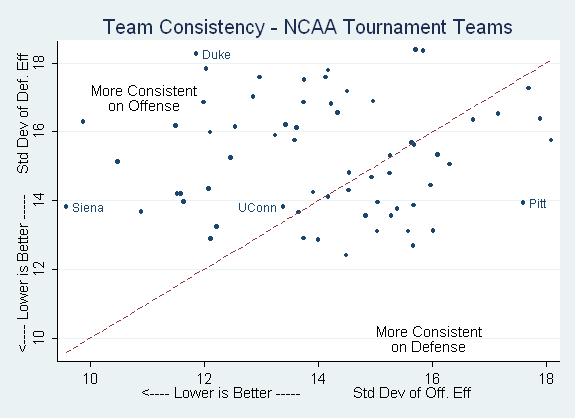Brackets, Parentheses, Braces: Why You Should Be Wary of Pitt
Posted by rtmsf on March 16th, 2009When Ben Allaire isn’t drumming up meaningless college basketball statistics, he’s writing about the Virginia Cavaliers over at Dear Old UVa. RTC appreciates having Ben stop over this week to make some numerical sense of this year’s NCAA Tournament field.
At its heart, the NCAA Tournament is about consistency. Just about all the teams (OK – maybe not Chattanooga) are qualified to make some sort of a deep run. The key is avoiding that one downer of a game that knocks a team out.
So, how should we look at consistency?
Well, it turns out there’s numerous ways to define consistency. Ken Pomeroy takes it to mean how volatile a team’s winning margin is. John Gasaway has dubbed it “The Winehouse Factor” after the roller-coaster-like life of Amy Winehouse. Joe Morgan uses it as an adjective to describe a baseball player’s fielding abilities, a team’s starting pitching, a hitter’s swing, the running the base paths, Jon Miller’s voice when dressed in drag, and the way his wife makes mashed potatoes.
Here’s the definition I’m proposing: when team X steps onto the court, can we expect what we’ve seen previously from team X, on average? Is team X’s offense white hot one night then colder than Jell-o pudding pops on another? Does the defense go through stretches where they stink, then miraculously are dominant?
I’ve taken all 2,126 performances from the 65 teams that have made the NCAA tournament from kenpom.com and plotted the standard deviation of the offensive efficiency versus the standard deviation of the defensive efficiency.
It’s much easier to be offensively consistent than defensively consistent. The majority of the points are to the Northwest of the red line, indicating that most teams are able to sustain their offensive production easier than their defensive production.
For a two seed, Duke is remarkably unstable in their defensive performances. This makes sense: at times they’ve appeared impenetrable (Maryland, Virginia, Miami), but others they’ve looked sieve-like (Clemson, Boston College, Michigan). Against UNC, they were pretty awful in both games, too. Ty Lawson and Co. have a way of making that happen.
I’ve lined up three teams that all have roughly the same defensive consistency: Siena, UConn, and Pitt. Now, remember, this doesn’t say “Who has the best defense?” The answer to that is clearly UConn, followed by Pitt and Siena (in that order).
Where this comes into play is what to expect from these teams offensively in the tournament.
In terms of adjusted offensive efficiency, no Big East team comes close to Pittsburgh. They average 117 points per 100 possessions (PPP); second in the country. So, on average, we can conclude that they are an offensive juggernaut.
However, there’s a ton of variation in their offensive performances. Sometimes, they’re out of this world. Other times, they’re completely inept. My guess is that you can figure out why. In case you can’t, we’ll delve into that more tomorrow.
UConn has a solid, if not unspectacular offense (20th in terms of offensive efficiency). This holds on a consistent basis. Only a few times during the season did UConn dip below the 100 PPP mark, but they topped the 120 PPP mark only a number of times as well.
Siena, in contrast, is like a metronome on offense. They’re the George Michael Bluth of offenses – they’re always on time keeping time. Granted, their offense, on average, isn’t nearly as good as UConn and Pitt. That’s not what I’m saying here. I’m saying that you can take their 107 PPP to the bank. They come out and that’s what they’re going to score.
So, what does this tell us? Pitt is all over the map. I’d be wary of them as a number one seed. UConn is a consistent, solid #1. If you think 107 PPP will get it done for Siena, pick them to beat Ohio State.
I should note, though, that this analysis doesn’t take into account strength of schedule. Perhaps it’s the case that Siena played a lighter schedule than UConn or Pitt and can therefore maintain its consistency through lesser opponents. But you can see that UConn and Pitt had approximately the same SOS and you realize that this might actually have some validity.
Tomorrow: combining the measures (more math, hooray!!!) to see the most consistent top seeds.












































Good stuff….anyway to get a sense of a few more teams. Particular the top 3 seeds. I am going to assume Pitt’s offensive ineptitude is a direct result of Mr. Blair sitting on the bench for extended periods of play when they look like a different team